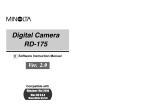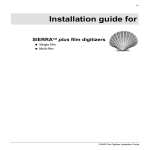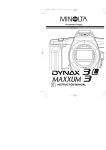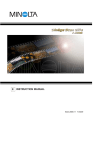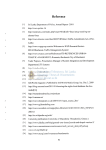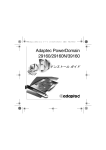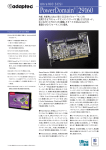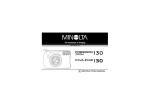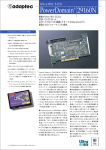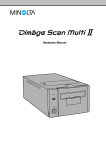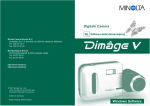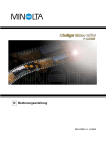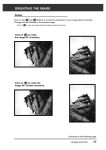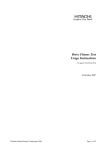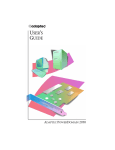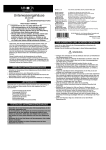Download minolta dimage rd 3000 User`s Manual
Transcript
E Software Instruction Manual Ver. 2.0 Downloaded from ManualsCamera.com Manuals The old version of the software (using Digita DesktopTM) isn’t guaranteed to operate correctly on Windows® Me/2000, or on Mac OS 9/9.0.2/9.0.4/9.1. Use the current version of the software (2.0) on these operating systems. This manual does not provide instructions for the basic operation of personal computers, or the basic operation of Windows® or Macintosh operating systems. Please refer to the manual that came with your computer for information on the above mentioned topics. • This instruction manual may not be copied either in part or in its entirety without the prior permission of Minolta Co., Ltd. © 2001 Minolta Co., Ltd. • Every precaution has been taken to ensure the accuracy of this material. Please contact Minolta if you have any questions, find any mistakes or notice missing information. • Minolta cannot accept responsibility for any loss, damage or other problems caused by use of this software. • With the exception of personal, home or equivalent use No part of book, magazine, music, or other copyrighted material may be used, copied or revised without the prior permission of the author or copyright holder. Downloaded from ManualsCamera.com Manuals • Microsoft® and Windows® are registerded trademarks in the United States and other countries of Microsoft Corporation. • The official name of Windows® is Microsoft® Windows® Operating System. • Pentium® is registered trademark of Intel Corporation. • Apple, the Apple logo, Macintosh, Power Macintosh, Mac OS and the Mac OS logo are registered trademarks of Apple Computer, Inc. • Other company and product names are the trademarks or registered trademarks of their respective owners. -1- TABLE OF CONTENTS TABLE OF CONTENTS BEFORE YOU BEGIN ..........................................................................4 STARTING THE SOFTWARE.............................................................32 TERNS USED IN THIS MANUAL.................................................................4 FOR WINDOWS® 95/98/98SE/Me/2000/NT 4.0................................................33 Starting the software from a TWAIN-compatible image processing application ............................................................33 Starting the RD 3000 Grabber utility software as a standalone application...............................................................37 FOR MACINTOSH ............................................................................................38 Starting the software as an Adobe Photoshop plug-in ..........................38 Starting the RD 3000 Grabber utility software as a standalone application...............................................................39 SYSTEM REQUIREMENTS (WINDOWS®)...........................................6 SYSTEM REQUIREMENTS (MACINTOSH).........................................8 INSTALLING THE SOFTWARE..........................................................10 FOR WINDOWS® 95/98/98SE/ME/2000/NT4.0..........................................10 FOR MACINTOSH......................................................................................14 INSTALLING THE ADOBE PHOTOSHOP PLUG-IN MODULE (MACINTOSH ONLY) .............................................................................18 CAMERA SETUP—SETTING THE CAMERA’S SCSI ID ..................20 CAMERA SETUP —SETTING THE TERMINATOR’S POWER SUPPLY ...................22 USING THE VIEWER PANEL (TWAIN DRIVER/PLUG-IN MODULE) .........................................................................................................41 READING IMAGES SAVED IN THE CAMERA (CF CARD), AND TRANSFERRING THEM TO AN IMAGE PROCESSING APPLICATION WINDOW ................................................................................................41 DELETING IMAGES SAVED IN THE CAMERA (CF CARD) .....................43 CAMERA SETUP —CONNECTING THE CAMERA TO YOUR COMPUTER .............24 USING THE MAIN PANEL (UTILITY SOFTWARE) ...........................44 SCSI CONNECTOR CABLES—FOR PC/AT-COMPATIBLE COMPUTERS ................................................................................................................24 SCSI CONNECTOR CABLES—FOR APPLE MACINTOSH COMPUTERS ................................................................................................................25 DISPLAYING CAMERA (CF CARD) IMAGES............................................50 DISPLAYING IMAGES SAVED ON THE HARD DISK ...............................54 SAVING IMAGES ON THE HARD DISK ....................................................56 DELETING IMAGES DISPLAYED IN THE VIEWER PANEL .....................61 CAMERA SETUP—INSERTING THE CF CARD ...............................27 REMOTE PHOTOGRAPHY (UTILITY SOFTWARE)..........................62 BASIC OPERATIONS.........................................................................28 USING THE PREVIEW PANEL (UTILITY SOFTWARE)....................66 OVERVIEW (MAIN PANEL, VIEWER PANEL) ..........................................28 SAVING AN IMAGE TAKEN BY REMOTE PHOTOGRAPHY....................66 DELETING AN IMAGE TAKEN BY REMOTE PHOTOGRAPHY ...............67 When starting the software from an image processing application using the TWAIN driver/plug-in module..................................................................28 The Viewer Panel lets you: ...................................................................28 When starting the RD 3000 Grabber utility software....................................29 Saved images can be: ...........................................................................29 OVERVIEW (MAIN PANEL, PREVIEW PANEL) ........................................30 The Main Panel lets you: .......................................................................30 The Preview Panel lets you: ..................................................................31 The saved image can be: ......................................................................31 -2Downloaded from ManualsCamera.com Manuals USING THE CAMERA PANEL (UTILITY SOFTWARE).....................68 FORMATTING THE CAMERA’S CF CARD................................................68 SYNCHRONIZING THE CAMERA’S CLOCK TO THE COMPUTER’S............70 QUITTING THE SOFTWARE (UTILITY SOFTWARE) .......................72 -3- BEFORE YOU BEGIN TERNS USED IN THIS MANUAL • This manual assumes that your computer’s operating system (Windows® 95/98/98 Second Edition/Me (Millennium edition)/2000/NT or Mac OS) as well as other necessary software such as device drivers have been installed, and are operating properly. • If you are using a Windows® OS, click the Start button, point to Settings, and click Control Panel. Double-click the System icon, then click the Device Manager tab. Verify that the name of your SCSI host adapter is displayed in the tree shown under the SCSI Controller icon. BEFORE YOU BEGIN • In general, the descriptions in this manual are illustrated by the displays for the Windows® version. There are no major differences between the displays for the Windows® and Macintosh versions except for some of the button layouts and other cosmetic features. • This manual assumes the use of a two-button, right-handed mouse for Windows®. The terms ‘click’ and ‘double-click’ refer to a single or double click of the left mouse button. The term ‘drag’ refers to the action of holding down the left mouse button while moving the mouse. • If you are using Macintosh OS, the term ‘Command Key’ refers to the key located next to the Space Bar. • Command names shown in this manual which are common both to the Windows® and Macintosh systems do not indicate any of the shortcut keys found in Windows® command names. Example No. 1: The File command appears as “File” on Windows® and “File” on Macintosh menus, but in this manual it is shown as merely as “File.” Example No. 2: The Save command appears as “Save” on Windows® and “Save” on Macintosh menus, but in this manual it is shown merely as “Save.” -4Downloaded from ManualsCamera.com Manuals -5- SYSTEM REQUIREMENTS (WINDOWS®) The system requirements for the operation of this software are as shown below: IBM PC/AT and their compatible computers CPU Intel Pentium® Processor 90MHz or higher OS Windows®95 (including OSR2) Windows®98 / Windows®98 Second Edition Windows®Me (Millennium edition) Windows®2000 Professional Windows®NT 4.0 RAM A minimum of 32MB of RAM on Windows®95, 98/98 Second Edition, Me or NT4.0, A minimum of 128MB of RAM on Windows®2000 Hard Disk Space 32MB or more of free hard disk space foe use as workspace Monitor VGA (640 x 480 dots) or higher / High Color (16-bit) CD-ROM Drive Required for software installation Recommended SCSI host adapters Adaptec AHA-1510B AVA-2902E*1 AHA-1540CP AHA-2910B AHA-2930C AHA-2930CU AHA-2940 AHA-2940U AHA-2940AU AHA-2940UW SCSI Card 19160 (ASC-19160) SCSI Card 29160N (ASC-29160N) SCSI Card 29160 (ASC-29160) SLIM SCSI 1460 (APA-1460) SLIM SCSI 1480 (APA-1480)*1,*2 SYSTEM REQUIREMENTS (WINDOWS®) Notes • When using Windows® 95 or NT 4.0, the Dimâge RD 3000 software’s setup program will install Winaspi version 4.57. If you install a driver for another SCSI device after you have installed the Dimâge RD 3000 software, the device driver’s setup program may automatically reinstall an older, incompatible version of Winaspi. Reinstall the Dimâge RD 3000 software if it stops running properly as a result. • When using the software with Windows® 2000 or NT 4.0, set the system’s virtual memory manually (M) to at least 100 MB. (This figure is just a guideline, and will depend on the applications you use at the same time as the Dimâge RD 3000 software, and other operating environment parameters.) For how to make the setting, see your PC’s manual or the Windows® help window. • The guarantee doesn’t cover the camera’s performance when it’s connected to a SCSI host adapter not shown on page 6, nor does it cover the SCSI host adapter or problems caused by it. Minolta doesn’t guarantee or provide customer support for the operation of the SCSI host adapter with your computer. • For the Windows®2000 Users: When the TWAIN_32 driver is started from Adobe Photoshop LE or Adobe Photoshop, the image transfer operation may stop halfway. In this case, check the memory allocation to Photoshop; if more than 20% of the memory is allocated to Photoshop, change the allocation to 20% or less. AHA-1520B AHA-2920C AHA-2930U2 AHA-2940W AHA-2940U2W *1 Can’t be used with Windows®NT 4.0. *2 Used with Windows®95 OSR2 later. Applications compatible with the operation of TWAIN drivers Adobe Photoshop Ver. 3.0.5 / 4.0.1 / 5.0.2 / 5.5 / 6.0 Adobe Photoshop 4.0 LE / 5.0 LE -6Downloaded from ManualsCamera.com Manuals -7- SYSTEM REQUIREMENTS (MACINTOSH) The system requirements for the operation of this software are as shown below: Apple Macintosh Series computers Macintosh computer (not a non-Macintosh Mac OScompatible computer) with PowerPC CPU and standard built-in SCSI port or PCI bus slot Computer OS Power Macintosh, Power Macintosh G3, Blue & White Power Macintosh G3 Series computer, Power Mac G4 Series computer (except Power Mac G4 Cube), PowerBook/PowerBook G3 with standard built-in SCSI port • Minolta doesn’t recommend connecting the camera to the Ultra2 Wide SCSI host adapter, which is a standard feature of some Blue & White Power Macintosh G3 Series models. This SCSI host adapter has a limited connectable length and other problems that prevent the computer from realizing its full performance potential. To use the camera with models that come with a standard Ultra2 Wide SCSI host adapter, mount any of the SCSI host adapters listed on page 10 in the empty slot, and connect the camera to the host adapter’s SCSI connector. Don’t remove the Ultra2 Wide SCSI host adapter. • The guarantee doesn’t cover the camera’s performance when it’s connected to a SCSI host adapter not shown on page 8, nor does it cover the SCSI host adapter or problems caused by it. Minolta doesn’t guarantee or provide customer support for the operation of the SCSI host adapter with your computer. (QuickTimeTM 3.0 or a later version must be installed) 16 MB or more of free memory Hard disk space 32 MB or more of free hard disk space for use as workspace Monitor 13’ (640 x 480 dots) or larger; 32,000 colors or more CD-ROM Drive Required for software installation Applications confirmed as compatible with the operation of the plug-in module Notes Mac OS 7.6.1 to 9.1 RAM Recommended SCSI host adapters SYSTEM REQUIREMENTS (MACINTOSH) For Power Macintosh, Power Macintosh G3, PowerBook, PowerBook G3: Standard built-in SCSI host adapter (Types that connect to an expansion board or PC card inserted in the PCI bus, NuBus or PC card slot can’t be used.) For Blue & White Power Macintosh G3 Series computers, Power Mac G4 Series computers: Adaptec PowerDomain 29160N PowerDomain 2940U2W PowerDomain 2940U2W PowerDomain 2930U SCSI Card 2906 Adobe Photoshop Ver. 3.0.5 / 4.0.1 / 5.0.2 / 5.5 / 6.0 Adobe Photoshop 4.0 LE / 5.0 LE -8Downloaded from ManualsCamera.com Manuals -9- INSTALLING THE SOFTWARE Follow one of the procedures below to install the Dimâge RD 3000 software on your Windows® or Macintosh computer. FOR WINDOWS® 95/98/98SE/Me/2000/NT4.0 INSTALLING THE SOFTWARE Select the language for the installation and click on “OK”. The License Agreement window appears (shown below). Read the entire agreement carefully before continuing the setup. If you don’t agree to the terms of the License Agreement, click ‘No’ to exit the setup program. • In the procedure below, the hard disk drive for system startup is drive C, and the CD-ROM drive is drive D. • Make sure the camera isn’t connected to the computer when you install the software. Turn on the computer to start Windows®. Insert the Dimâge RD 3000 CD-ROM into the CD-ROM drive. After a short wait, the InstallShield Wizard program starts automatically, then the choose Setup Lunguage window opens. Click “Yes”. The window for selecting the folder in which to install the software appears (shown below). If the InstallShield Wizard program doesn’t start automatically, select ‘Start’ ‘Run…’. Enter ‘D:\Driver\Setup.exe’ in the ‘Open’ drop-down list and click “OK”. Continued on Next Page - 10 Downloaded from ManualsCamera.com Manuals - 11 - INSTALLING THE SOFTWARE INSTALLING THE SOFTWARE To install the software in the default folder (C:\Program Files\MINOLTA\Dimage RD 3000), press “Next>”. To install the software in another folder, click “Browse...” to display the window for selecting a folder. Specify the directory to install the software in, then click “OK”. Click “Next>” to display the window for selecting the setup type (shown below). The name of the default Program Folder is displayed in reverse. To add the software icons to this folder, click “Next>”. Select the setup type, then press “Next>”. To add the software icons to another existing folder, select it from the folders listed in the box below ‘Existing Folders:’, then click “Next>”. Installation starts when you click “Next>”. When it has finished, the ‘InstallShield Wizard Complete’ window appears (shown below). Normally, select “Typical”. The rest of the descriptions in this manual assume the “Typical” setup has been selected. “Compact”: Installs the software with the minimum number of required options. The software may not run normally with this selection on some system environments. “Custom”: Installs only the selected option. Select ‘Custom’ to install just the TWAIN module, or just the RD 3000 Grabber utility software. This setup type is intended for users with a thorough knowledge of the software. Click “Next>” to display the window for selecting the Program Folder (shown on the next page). Check that ‘Yes, I want to restart my computer now.’ is selected, then click “Finish”. Setup ends, and the computer restarts. - 12 Downloaded from ManualsCamera.com Manuals - 13 - INSTALLING THE SOFTWARE FOR MACINTOSH Before you begin Virus protection tools and control panel documentation can cause problems during installation, so remove or temporarily disable these programs during installation. They can be restored afterwards. INSTALLING THE SOFTWARE Click “Accept”. • A window appears for selecting the installation method (‘Easy Install’ is selected initially) and the installation location. The names of the volume (disk) name and folder in which the software will be installed appear at the bottom-left of the window. Select the installation method to use. • Make sure the camera isn’t connected to the computer when you install the software. Name of the volume (disk) and folder in which the software will be installed. Turn on the computer to start Mac OS. When the desktop appears, insert the Dimâge RD 3000 CD-ROM into the CD-ROM drive. Select or create the folder in which to install the software. Double-click the CD-ROM drive on the desktop to open it. Double-click the “Driver” folder to open it, then doubleclick the “English” folder. • The ‘Dimage RD 3000 Installer’ icon appears. Double-click the “Dimage RD 3000 Installer” icon. • The installer program starts, and the initial window appears. Click “Continue...” in the Installer’s initial window. • The Software License Agreement appears. Read the entire agreement carefully before continuing. • You can click “Save As...” to save the Software License Agreement as a text file, or “Print” to print it out. • If you don’t agree to the terms of the Software License Agreement, click “Decline” to exit the installer. Check the folder in which the software will be installed. To change it, select “Select folder...” from the ‘Install location:’ pop-up menu, then select an existing folder or create a new one. Select the installation method from the pop-up menu at the top-left. Normally, you don’t need to change the installation method from “Easy Install”. • If you select “Custom Install”, the window below appears. Click ‘I’ to the right of a file to display its information. Check the check box of the file you want to install. Continued on Next Page - 14 Downloaded from ManualsCamera.com Manuals - 15 - INSTALLING THE SOFTWARE INSTALLING THE SOFTWARE Click “Install”. Items installed • Installation starts. Follow the instructions that appear on the screen. • If Adobe® Photoshop® (LE) has been installed, the plug-in module (‘RD3000 Plugin’) is automatically installed in the ‘Import/Export’ folder in Photoshop’s ‘Plug-ins’ folder. • If multiple versions of Adobe® Photoshop® (LE) have been installed, the screen shown below appears, letting you select the version of Photoshop in which to install the plug-in module (‘RD3000 Plug-in’). If you selected ‘Easy Install’, all the files/folders below were installed. If you selected ‘Custom Install’, only the selected (checked) file/folder was installed. Items installed in the selected/created folder: RD 3000 Grabber . . . . . (the application itself) Put into Plug-in Folder . . (contains plug-in for Adobe Photoshop (‘RD3000 Plug-in’)) Installer Log File . . . . . . (text file listing each file the installer program installed, and where it was installed) Item installed in the “Import/Export” folder in the “Plug-ins” folder in the version of Photoshop (selected in Step 11): RD 3000 Plug-in . . . . . . (plug-in module) Select the desired version of Photoshop®, then click “OK”. • Installation continues. Follow the instructions that appear on the screen. • If you press “Cancel” instead, you can still install the plug-in module later (see pages 18 - 19). • If Adobe® Photoshop® (LE) hasn’t been installed, or if only one version has been installed, the screen above doesn’t appear, and installation finishes. • When installation has finished, the screen below appears. Click “Quit”. - 16 Downloaded from ManualsCamera.com Manuals - 17 - INSTALLING THE SOFTWARE INSTALLING THE SOFTWARE Installing the Adobe Photoshop plug-in module (Macintosh only) By installing the plug-in module in the specified folder, you can open RD3000 Plug-in from Adobe Photoshop. When you install the Dimage RD 3000 software, the plug-in module is automatically installed in a predetermined folder if Adobe Photoshop has been installed on the computer. If multiple versions of Adobe Photoshop have been installed, you can select the version of Photoshop in which to install the plug-in module (see page 16). Note that the plug-in module isn’t installed automatically if you install Adobe Photoshop after installing the Dimage RD 3000 software, or if you select not to install the plug-in module. In this case, you can install the plug-in module manually later on by following the steps below. You don’t need to install the plug-in module if using the RD 3000 Grabber utility software as a standalone application. Quit Adobe Photoshop (LE) if it’s running. Open the Adobe Photoshop (LE) folder. Open the “Plug-ins” folder in the Adobe Photoshop (LE) folder. Open the ‘Minolta RD3000’ folder, and then the ‘Put into Plug-in Folder’ within it. Drag-and-copy the “RD3000 Plug-in” icon from the ‘Put into Plug-in Folder’ to the “Import/Export” folder in the “Plug-ins” folder. Drag-and-copy the “RD3000 Plug-in” icon from the ‘Put into Plug-in Folder’ to the “Import/Export” folder in the “Plug-ins” folder. - 18 Downloaded from ManualsCamera.com Manuals - 19 - CAMERA SETUP—SETTING THE CAMERA’S SCSI ID CAMERA SETUP—SETTING THE CAMERA’S SCSI ID To enable your computer to correctly identify each SCSI device connected to it, each device must be assigned a unique SCSI ID between 0 and 7. Some computer models have some reserved SCSI IDs that can’t be used (see table below). Press or to move the cursor to SCSI, then press the SET button. • The SCSI menu appears. Reserved SCSI IDs (devices reserved for) PC/ATcompatible computers Apple Macintosh computers 7 (SCSI host adapter) Press or to move the cursor to ID, then press the SET button. 0 (built-in hard disk drive) *1 3 (built-in CD-ROM drive) *1,*2 7 (computer itself) • The ID List appears. 1 * Some recent Macintosh models have IDE hard disk/CD-ROM drives instead of SCSI hard disk/CD-ROM drives. SCSI IDs 0 and 3 are available on these models. *2 Some Macintosh models have both an internal and external SCSI bus. The SCSI ID for the external bus (3) is available on these models. Press or to move the cursor to the ID you want to assign to the camera, then press the SET button. The camera’s SCSI ID is set to 4 at the time of purchase. If this ID is available, you don’t need to change the SCSI ID setting before use. Otherwise, check the SCSI ID assigned to each connected SCSI device, and follow the steps below to assign an unused SCSI ID to the camera. • The selected ID is set, and the screen returns to the SCSI menu. • The set ID is retained even after the camera is turned off. Turn the camera’s Main Switch/Mode Selector dial to PLAY, then press the MENU button on the back of the camera. Press or to move the cursor to CANCEL, then press the SET button. Alternately, press the MENU button twice. • The Top Menu appears on the LCD screen. - 20 Downloaded from ManualsCamera.com Manuals - 21 - CAMERA SETUP—SETTING THE TERMINATOR’S POWER SUPPLY CAMERA SETUP—SETTING THE TERMINATOR’S POWER SUPPLY The camera only has one SCSI connector, so it can only be used as the final device on a SCSI chain. It therefore requires a device called a terminator, which is built into the camera. This terminator requires a power source. Press or to move the cursor to TERMPWR, then press the SET button. For IBM PC/ATs and compatible computers Check the user’s manual of your SCSI host adapter to determine whether the SCSI host adapter you are using supplies power to the terminator. If it does, you don’t need to perform the steps below. Otherwise, follow the steps below to enable the camera to supply power to the terminator. • A screen for selecting ON or OFF appears. For Macintosh computers Users of desktop, mini-tower Power Macintosh/Power Macintosh G3 models, and of Blue & White Power Macintosh G3 Series/Power Mac G4 Series models don’t need to perform the steps below. Users of PowerBook and PowerBook G3 models with PowerPC CPUs need to follow the steps below to enable the camera to supply power to the terminator. Press or to move the cursor to ON, then press the SET button. • The camera is set to supply power, and screen returns to the SCSI menu. • The setting is retained even after the camera is turned off. Turn the camera’s Main Switch/Mode Selector dial to PLAY, then press the MENU button on the back of the camera. Press or to move the cursor to CANCEL, then press the SET button. Alternately, press the MENU button twice. • The Top Menu appears on the LCD screen. Press or to move the cursor to SCSI, then press the SET button. • The SCSI menu appears. - 22 Downloaded from ManualsCamera.com Manuals - 23 - CAMERA SETUP—CONNECTING THE CAMERA TO YOUR COMPUTER CAMERA SETUP—CONNECTING THE CAMERA TO YOUR COMPUTER SCSI CONNECTOR CABLES—For Apple Macintosh computers Before connecting the camera to your computer, be sure to turn off the camera, computer and all connected devices. Connecting the camera to your computer when the power is on could damage the computer, camera, and other connected devices. • To turn off the camera, turn the Main Switch/Mode Selector dial to OFF. When the camera is the only SCSI device connected: For desktop and mini-tower Power Macintosh and Power Macintosh G3 computers: Use a SCSI cable with a standard Macintosh SCSI port connector at one end (male D-Sub 25-pin connector), and a male 50-pin Wide connector at the other end. For Blue & White Power Macintosh G3 Series computers and Power Mac G4 Series computers: Use a SCSI cable with a connector that matches the connector of your host adapter at one end, and has a male 50-pin Wide connector at the other end. For PowerBook and PowerBook G3 computers with PowerPC CPUs: Use a SCSI cable that has a connector that matches the PowerBook SCSI host adapter (HDI-30) at one end, and has a male 50-pin Wide connector at the other end. SCSI CONNECTOR CABLES—For PC/AT-compatible computers When the camera is the only SCSI device connected: If the SCSI host adapter has a 50-pin Wide connector: Use a SCSI cable with male 50-pin Wide connectors at both ends. If the SCSI host adapter has another type of connector: Use a SCSI cable with a connector that matches the connector of your host adapter at one end, and has a male 50-pin Wide connector at the other end. When the camera is the final device on a SCSI chain: If the current terminal SCSI device has a 50-pin Wide connector: Use a SCSI cable with male 50-pin Wide connectors at both ends. If the current terminal SCSI device has another type of connector: Use a SCSI cable with a connector that matches the connector of the current terminal SCSI device at one end, and has a male 50-pin Wide connector at the other end. When the camera is the final device on a SCSI chain: If the current terminal SCSI device has a 50-pin Wide connector: Use a SCSI cable with male 50-pin Wide connectors at both ends. If the current terminal SCSI device has another type of connector: Use a SCSI cable with a connector that matches the connector of the current terminal SCSI device at one end, and has a male 50-pin Wide connector at the other end. Continued on Next Page - 24 Downloaded from ManualsCamera.com Manuals - 25 - CAMERA SETUP—CONNECTING THE CAMERA TO YOUR COMPUTER Open the camera’s connector cover. CAMERA SETUP—INSERTING THE CF CARD How to insert the CompactFlash Card (CF Card) into the camera’s card slot is described on pages 32 and 33 in the Dimâge RD 3000 manual. Align the 50-pin Wide SCSI cable connector to the camera’s SCSI connector, and press it in firmly until it clicks into place. When the camera is the only connected SCSI device: Attach the other end of the SCSI cable to the computer’s SCSI host adapter. When the camera is the final device on a SCSI chain: Remove the terminator of the current terminal SCSI device (or disable it if built-in), and attach the other end of the SCSI cable to the device’s SCSI host adapter. - 26 Downloaded from ManualsCamera.com Manuals - 27 - BASIC OPERATIONS OVERVIEW (MAIN PANEL, VIEWER PANEL) To display and save (thumbnail) images saved in the camera (in the CompactFlash card (CF Card)) on the computer: BASIC OPERATIONS ■ When starting the RD 3000 Grabber utility software Start the utility software (see pages 37, 39). ■ When starting the software from an image processing application using the TWAIN driver/plug-in module The Main Panel appears. Start the image processing application (Adobe Photoshop). Click the “Camera” button in the Main Panel. For Windows® Select “RD3000” as ‘TWAIN_32 Source...’, then select “TWAIN_32...”. For Macintosh Select “File” “Import” “RD3000 Plug-in”. The Viewer Panel appears, displaying thumbnail images of the files saved in the camera (in the CF Card) (see page 39). The Viewer Panel lets you: • Display all the images saved in the camera (CF Card) as thumbnail images. • Transfer some or all of the images saved in the camera (CF Card) to an image processing application, for display in a window of that application (when using the TWAIN driver or plug-in module). • Save some or all of the images saved in the camera (CF Card) on the connected computer’s hard disk or a similar memory storage device, in various image file formats (when using the RD 3000 Grabber utility software). • Display (as thumbnail images) images saved on the computer’s hard disk or similar memory storage device (when using the RD 3000 Grabber utility software). • Delete some or all of the images displayed (as thumbnail images) in the Viewer Panel. For information on each operation, see pages 41 to 43 and 50 to 61 in this manual. - 28 Downloaded from ManualsCamera.com Manuals The Viewer Panel appears, displaying the images saved in the camera (CF Card) as thumbnail images (see page 50). Select the thumbnail images you want to save, by clicking on them. Click “Save” in the Viewer Panel (see page 57). Select the folder and image file format in which to save the images. Enter the desired file name, then click “Save” (see pages 57 - 60). The images are saved as a file. Saved images can be: • Displayed in the Viewer Panel. • Loaded into other application software. - 29 - BASIC OPERATIONS OVERVIEW (MAIN PANEL, PREVIEW PANEL) To operate the camera from the computer: Set the image quality and white balance on the camera (see pages 40 to 41 and 58 to 61 in the Dimâge RD 3000 manual). BASIC OPERATIONS The Preview Panel lets you: • Display an image taken by remote photography, which has been read from the camera. • Save the image from the Preview Panel to the computer’s hard disk or similar memory storage device, in various image file formats. • Delete the image displayed in the Preview Panel. For information on each operation, see pages 66 to 67 in this manual. Click “Save” in the Viewer Panel (see page 66). Start the utility software (see pages 37, 39). Select the folder and image file format in which to save the images. Enter the desired file name, then click “Save” (see pages 57 - 60). The Main Panel appears. The Main Panel lets you: The images are saved as a file. • Check the approximate numbers of images left/taken. • Use the computer to control camera functions (perform remote photography with or without exposure/flash correction, set the camera’s built-in clock, and initialize the CF Card). The saved image can be: For information on each operation, see pages 44 to 72 in this manual. • Displayed in the Viewer Panel. • Loaded into other application software. Set Exposure/Flash compensation from the Main Panel as needed. Click the “Capture” button on the Main Panel. The Preview Panel opens, displaying the image taken by remote photography (see page 64). - 30 Downloaded from ManualsCamera.com Manuals - 31 - STARTING THE SOFTWARE Perform the camera setup procedures on pages 20 to 27 in this manual. Turn the camera’s Main Switch/Mode Selector dial to PLAY, then press the MENU button on the back of the camera. STARTING THE SOFTWARE ■FOR WINDOWS® 95/98/98SE/Me/2000/NT4.0 Starting the software from a TWAIN-compatible image processing application In the description below, the TWAIN-compatible image processing application is Adobe Photoshop 5.0 LE. The screen displays, commands and operations may be different in other image processing applications. See the image processing application’s manual for more information. • The Top Menu appears on the LCD screen. Press or to move the cursor to SCSI, then press the SET button. • The SCSI menu appears. Turn on the computer and start Windows®. The ‘New Hardware Found’ dialog appears. Select ‘Do not install a driver’,and click “OK”. Repeat this operation until the ‘New Hardware Found’ dialog no longer appears. Press or to move the cursor to CONNECT, then press the SET button. The two screens shown here appear in computers with Windows®95 OSR2 preinstalled at the time of purchase. Click “Next>” in the first screen and “Finish” in the next screen. • CONNECT TO PC appears on the LCD screen, and the camera enters the SCSI connection mode. In Windows®98, click “Next>” until “Finish” appears, then press “Finish”. Turn on the other SCSI devices if any are connected. When connecting the RD3000 camera to the computer, “Add New Hardware Wizard” dialog box may appear as shown in the figure. Install the driver software by following the indication of the dialog box (refer to the procedure described on the following pages). Continued on Next Page - 32 Downloaded from ManualsCamera.com Manuals - 33 - STARTING THE SOFTWARE STARTING THE SOFTWARE (1) When “Add New Hardware Wizard” dialog box appears, click [Next >]. (2) When the dialog box as shown on the left appears, select “Search for the best driver for your device. (Recommended)” and click [Next >]. (3) When the dialog box as shown on the left appears, insert the Dimage RD3000 Ver.2.0 CD-ROM into the CDROM drive and put the check mark on “CDROM drive” and click [Next >]. (4) When the device driver is detected and the dialog box as shown on the left appears, click [Next >]. • Confirm that “X:\DIMAGWDM.INF” appears under the text “Location of driver:” (where “X” is a drive letter assigned to the CD-ROM drive on your computer - it is the D drive in this example). • If the message “Please insert the disk labeled ‘Windows XX CD-ROM’, and then click OK.” appears during installation (XX represents a Windows® version such as ‘98’ or ‘Me’), remove the Dimage RD3000 Ver.2.0 CD-ROM from the CD-ROM drive, insert the Windows®XX CD-ROM into the CD-ROM drive, then click [OK]. If another message appears prompting you to insert a different disk, follow the instruction that apperas on the screen. (5) When the installation of the driver software is completed and the dialog box as shown on the left appears, click [Finish]. <Continued from page 32.> Start Adobe Photoshop 5.0 LE. In Adobe Photoshop 5.0 LE, select “File” “Select TWAIN_32 Source...”. “Import” • A screen for selecting the TWAIN source appears. Continued on Next Page - 34 Downloaded from ManualsCamera.com Manuals - 35 - STARTING THE SOFTWARE STARTING THE SOFTWARE Starting the RD 3000 Grabber utility software as a standalone application If you don’t have a TWAIN-compatible image processing application, use the RD 3000 Grabber utility software as a standalone application. <Continued from page 32.> Turn on the computer and start Windows®. Select “Start” “Programs” 3000” “Dimage RD 3000”. Select Dimage RD 3000 from the source list, then click “Select”. Select “File” “Import” • The RD 3000 Grabber utility software starts, and the Main Panel (see page 44) appears. “TWAIN_32...”. • The software starts, and the Viewer Panel (see page 41) appears in an Adobe Photoshop 5.0 LE window. - 36 Downloaded from ManualsCamera.com Manuals “Minolta Dimage RD - 37 - STARTING THE SOFTWARE STARTING THE SOFTWARE ■FOR MACINTOSH Starting the RD 3000 Grabber utility software as a standalone application Starting the software as an Adobe Photoshop plug-in In the description below, RD3000 Plug-in is installed in Adobe Photoshop 5.0 LE’s ‘Import/Export’ folder. See page 18 in this manual for how to install the RD3000 Plug-in module. <Continued from page 32.> Turn on the computer and start Mac OS. <Continued from page 32.> Turn on the computer and start Mac OS. Open the folder in which the application was installed (the folder selected or created during installation). Start Adobe Photoshop 5.0 LE. In Adobe Photoshop 5.0 LE, select “File” “RD3000 Plug-in Ver. 2.0...”. If you don’t have Adobe Photoshop, use the RD 3000 Grabber utility software as a standalone application. “Import” Double-click the ‘RD3000Grabber’ application icon. • The RD 3000 Grabber utility software starts, and the Main Panel (see page 44) appears after a short wait. • The software starts, and the Viewer Panel (see page 41) appears in an Adobe Photoshop 5.0 LE window. Double-click the ‘RD3000Grabber’ application icon. - 38 Downloaded from ManualsCamera.com Manuals - 39 - USING THE VIEWER PANEL (TWAIN DRIVER/PLUG-IN MODULE) The screens displayed by the software, the screen order, and the functions available differ depending on whether the software was started from an image processing application using the TWAIN driver/plug-in module, or the RD 3000 Grabber utility software was started. Viewer Panel display of images saved on the computer’s hard disk (see page 54), Remote photography (see page 62), and Camera Panel operations (see pages 68 to 71) are only available when the RD 3000 Grabber utility software was started. These functions can’t be used when the software was started using the TWAIN driver/plug-in module. READING IMAGES SAVED IN THE CAMERA (CF CARD), AND TRANSFERRING THEM TO AN IMAGE PROCESSING APPLICATION WINDOW When the software is started from an image processing application using the TWAIN driver/plug-in module, once the software has correctly recognized the camera (camera connection), the Viewer Panel (shown below) appears, displaying the images recorded in the camera (CF Card). When starting the software from an image processing application using the TWAIN driver/plug-in module: See pages 41 to 43. When starting the RD 3000 Grabber utility software: See pages 44 to 72. Continued on Next Page - 40 Downloaded from ManualsCamera.com Manuals - 41 - USING THE VIEWER PANEL (TWAIN DRIVER/PLUG-IN MODULE) Select the Viewer Panel images you want to transfer to the image processing application, by clicking on them. • Selected images are displayed in reverse. • A selected image can be deselected by clicking on it again with the Ctrl key (Command key on Macintosh) held down. • To select more than one image, hold down the Ctrl key (Command key on the Macintosh) when clicking on the second and subsequent images. • To select the succeeding images, click the first image, then click the last image while pressing down the shift key. • To select all the images, click “Select All” in the Viewer Panel, or press Ctrl + A (Command ( ) + A on Macintosh) on the keyboard. Click “Transfer” in the Viewer Panel. • A meter window appears while the images are being transferred, indicating how far the process has advanced. USING THE VIEWER PANEL (TWAIN DRIVER/PLUG-IN MODULE) DELETING IMAGES SAVED IN THE CAMERA (CF CARD) Some or all of the images displayed by the Viewer Panel (as thumbnail images) can be deleted from the CF Card. The thumbnail images in the Viewer Panel let you check the images to delete. Select the Viewer Panel images you want to delete by clicking on them. • Selected images are displayed in reverse. • A selected image can be deselected by clicking on it again with the Ctrl key (Command key on Macintosh) held down. • To select more than one image, hold down the Ctrl key (Command key on the Macintosh) when clicking on the second and subsequent images. • To select the succeeding images, click the first image, then click the last image while pressing down the shift key. • To select all the images, click “Select All” in the Viewer Panel, or press Ctrl + A (Command ( ) + A on Macintosh) on the keyboard. Click “Delete” in the Viewer Panel. • A confirmation dialog appears. • When transfer has finished, the images are loaded into the image processing application, and displayed in a window of that application. You can now use the image processing application to manipulate the images as desired. See the manual of the image processing application. To delete the images, click “Yes”. To cancel deletion, click “No”. Follow the steps on pages 52 to 53 if the message above is displayed, and Viewer Panel doesn’t open. - 42 Downloaded from ManualsCamera.com Manuals While the RD3000 driver software (TWAIN Data Source) is running, do not operate image processing applications such as Adobe Photoshop; the RD3000 driver software (TWAIN Data Source) may freeze. If this occurs, re-start the computer or force the RD3000ListView to quit by pressing the Ctrl, Alt, and Delete keys simultaneously. - 43 - USING THE MAIN PANEL (UTILITY SOFTWARE) When you start the RD 3000 Grabber utility software, once the software has correctly recognized the camera (camera connection), the Main Panel appears (shown below). Click to display images stored in camera. The meaning of each display and the function of each button in the Main Panel is shown below. Display/button Meaning of display; function of button See page(s): ‘Left:’ display The number of images that can be taken (recorded) on the CF Card currently in the camera. ‘– –’ is displayed if the camera isn’t connected or there is no CF Card in the camera. ‘0’ is displayed when no more images can be taken. 44, 62 ‘Taken:’ display The number of images that have been recorded on the CF Card currently in the camera. ‘– –’ is displayed if the camera isn’t connected or there is no CF Card in the camera. 44 Opens the Viewer Panel (see pages 50 and 56 to 61), which displays the images recorded on the CF Card currently in the camera (as ‘Camera’ button thumbnail images). Disabled when the camera isn’t connected, when there is no CF Card in the camera, or when ‘Taken:’ is 0. 50 Displays a standard operating system dialog for specifying a folder. When you specify a folder, the Viewer Panel (see pages 54 and 56 to 61) opens, and the images in the specified folder are displayed (as thumbnail images). 54 Click to display images stored on hard disk. Number of images left Number of images taken Click to display/hide the lower part of the window, which is used to set exposure/flash compensation ( / on Macintosh). USING THE MAIN PANEL (UTILITY SOFTWARE) Click to perform remote photography. Exposure compensation display Click to make camera settings. Close button ( on left side of Main Panel’s title bar on Macintosh) Disk’ button Continued on Next Page Flash compensation display Exposure compensation value display/input field Flash compensation slider Exposure compensation slider - 44 Downloaded from ManualsCamera.com Manuals Flash compensation value display/input field - 45 - USING THE MAIN PANEL (UTILITY SOFTWARE) Display/button Meaning of display; function of button Takes an image by sending a signal to the connected camera through the SCSI cable (remote photography). The image taken is added to the end of the Viewer Panel, and the Preview ‘Capture’ button Panel (see page 64) opens and the image is also displayed there. Disabled when the camera isn’t connected, when there is no CF Card in the camera, or when ‘Taken:’ is 0. Opens the Camera Panel (see page 69), which is used to initialize the CF Card in the camera, ‘Setting...’ button and set the camera’s built-in clock. Disabled when the camera isn’t connected, or there is no CF Card in the camera. Exposure compensation display Indicates that exposure compensation is set. When exposure compensation isn’t set (value is ‘0’), this display disappears in the Windows® version of the software, and appears gray (is grayed-out) in the Macintosh version. See page(s): 62 to 65 USING THE MAIN PANEL (UTILITY SOFTWARE) Display/button Meaning of display; function of button See page: Flash compensation display Meaning of display; function of button Indicates that flash compensation is set. When flash compensation isn’t set (value is ‘0’), this display disappears in the Windows® version of the software, and appears gray (is grayed-out) in the Macintosh version. 63 Arrow button Displays or hides the lower part of the window, which is used for setting exposure/flash correction. 63 Exposure compensation slider Dragging the slider knob sets the exposure compensation value. The value can be set between -3.0 and +3.0, in 0.5 increments. During remote photography, this setting is sent to the camera and applied to the result. This slider is disabled when the camera isn’t connected. 63 Flash compensation slider Dragging the slider knob sets the flash compensation value. The value can be set between -3.0 and +3.0, in 0.5 increments. During remote photography, this setting is sent to the camera and applied to the result. This slider is disabled when the camera isn’t connected. 63 68 to 71 63 Continued on Next Page - 46 Downloaded from ManualsCamera.com Manuals - 47 - USING THE MAIN PANEL (UTILITY SOFTWARE) Display/button Meaning of display; function of button See page: Displays the currently set exposure compensation value. The displayed value changes as you Exposure operate the exposure compensation slider. You compensation can click on this field to enter an exposure value compensation value (between -3.0 and 3.0) display/input field directly from the keyboard. This operation is disabled when the camera isn’t connected. 63 Displays the currently set flash compensation value. The displayed value changes as you Flash operate the flash compensation slider. You can compensation click on this field to enter a flash compensation value value (between -3.0 and 3.0) directly from the display/input field keyboard. This operation is disabled when the camera isn’t connected. 63 Close button Quits the driver software. - 48 Downloaded from ManualsCamera.com Manuals USING THE MAIN PANEL (UTILITY SOFTWARE) 72 - 49 - USING THE MAIN PANEL (UTILITY SOFTWARE) DISPLAYING CAMERA (CF CARD) IMAGES Click the “Camera” button in the Main Panel. • The Viewer Panel opens, and the images stored in the camera (on the CF Card) are displayed. USING THE MAIN PANEL (UTILITY SOFTWARE) • The images displayed by the Viewer Panel can be saved on the connected computer in any location (folder), in any of four image formats. See page 56 in this manual for more information. • The “Camera” button is disabled when the camera isn’t connected, when there is no CF Card in the camera, or when ‘Taken:’ is 0. • The Viewer Panel screen shot shown on page 50 is the screen displayed when using the RD 3000 Grabber utility software. When using the TWAIN driver/plug-in module, the Viewer Panel’s “Save” button is replaced by the “Transfer” button (shown below). - 50 Downloaded from ManualsCamera.com Manuals - 51 - USING THE MAIN PANEL (UTILITY SOFTWARE) USING THE MAIN PANEL (UTILITY SOFTWARE) (5) After checking the points above, follow the steps on pages 32 to 39 in this manual to start the software again. Follow the steps below if the message above is displayed, and Viewer Panel doesn’t open. (1) Click “OK” to close the message window. (2) Click the close button on the top-right of the Main Panel (select “File’ “Quit” on Macintosh) to quit the software. (3) Turn off the camera and computer. (4) Check the following points: • Is the SCSI cable connected properly? Follow the steps on pages 24 to 26 to check its connection. • Is the SCSI cable partially disconnected from the connector? Press it in until it clicks into place. • Is there a break in the SCSI cable or its covering? Replace the cable with a new one. • Is the SCSI ID assigned to the camera the same as the ID of another SCSI device connected to the same computer? Follow the steps on pages 20 to 21 to change the camera’s SCSI ID to a unique ID. • Is the power supply to the terminator set properly? Follow the steps on pages 22 to 23 to set it properly. • Was the camera turned on before the computer was turned on? (Was the computer turned on after the camera was set to PC connection mode?) Turn the camera on, set it to PC connection mode, then turn the computer on. • Is there a CF Card in the camera? Follow the steps on page 27 to insert a CF Card in the camera. - 52 Downloaded from ManualsCamera.com Manuals - 53 - USING THE MAIN PANEL (UTILITY SOFTWARE) DISPLAYING IMAGES SAVED ON THE HARD DISK Click the “Disk” button in the Main Panel. USING THE MAIN PANEL (UTILITY SOFTWARE) Select a folder (directory) in which image data has been saved, then click “OK”. • The Viewer Panel opens, displaying the images saved in the selected folder. • The screen for selecting a folder (directory) appears. * The Viewer Panel displays image files in TIFF, JPEG, BMP (Windows® only) or PICT (Macintosh only) format. Files saved in other image formats (such as PNG, PSD or GIF) can’t be displayed. * When the software was started using the TWAIN driver/plug-in, the Main Panel doesn’t appear, so you can’t display images saved on the computer’s hard disk in the Viewer Panel. * The file formats of images displayed by the Viewer Panel can be changed to one another. The procedure is as almost same as that of SAVING IMAGES ON THE HARD DISK described on the next page Refer to the pages 56 - 60 for details. - 54 Downloaded from ManualsCamera.com Manuals - 55 - USING THE VIEWER PANEL (UTILITY SOFTWARE) SAVING IMAGES ON THE HARD DISK USING THE VIEWER PANEL (UTILITY SOFTWARE) Click “Save” in the Viewer Panel. • The screen for selecting the folder (directory) in which to save the images appears (shown below). Select the folder (directory) in which to save the images. Enter the name of the file in which to save the images. Use the drop-down list (pop-up menu on Macintosh) to select the image format in which to save the images. Select the Viewer Panel images you want to save to the computer’s hard disk or a similar memory storage device, by clicking on them. • Selected images are displayed in reverse. • A selected image can be deselected by clicking on it again with the Ctrl key (Command key on Macintosh) held down. • To select more than one image, hold down the Ctrl key (Command key on the Macintosh) when clicking on the second and subsequent images. • To select the succeeding images, click the first image, then click the last image while pressing down the shift key. • To select all the images, click “Select All” in the Viewer Panel, or press Ctrl + A (Command ( ) + A on Macintosh) on the keyboard. Select the folder (directory) in which to save the images, and the name of the file in which to save them. Continued on Next Page - 56 Downloaded from ManualsCamera.com Manuals - 57 - USING THE VIEWER PANEL (UTILITY SOFTWARE) Use the drop-down list (pop-up menu on Macintosh) to select the image format in which to save the images. USING THE VIEWER PANEL (UTILITY SOFTWARE) • When “JPEG” is selected, click [Setting...]([Option...] on Macintosh) to set the image quality. • In Windows®, you can select ‘Original Format’, or the JPEG, Bitmap, or TIFF format. • In Macintosh, you can select ‘Original Format’, or the JPEG, PICT, or TIFF format. • If you select “Original Format”, the images are saved in the same file format they were recorded in on the CF Card (shown below). The format in which the camera records image files on the CF Card is determined by the image quality setting (see page 40 in the Dimâge RD 3000 manual). Image quality setting Format S.FINE TIFF (uncompressed) FINE JPEG (approx. 1/5 compression) STD. JPEG (approx. 1/10 compression) ECON. JPEG (approx. 1/15 compression) Note When the camera’s image quality setting is ‘FINE’, ‘STD’. or ‘ECON.’, image data is recorded on the CF Card as JPEG format image files (with a different compression ratio for each setting). If you use the software to read these image data files and save them on the hard disk in JPEG image format, image data originally compressed by the camera may be further compressed by the software, further reducing the image quality. (Compressed JPEG data can’t be restored to its original state.) Therefore, when using the software to read and save images recorded by the camera with the ‘FINE’, ‘STD’. or ‘ECON.’ image quality setting, it’s a good idea to select ‘Original Format’ to prevent a reduction in image quality. • Drag the Quality slider knob and click [OK]. • A higher quality setting will produce a saved image of higher quality, but the file size will increase accordingly. • A lower quality setting will produce smaller file sizes, but the saved image will be of lower quality. Continued on Next Page - 58 Downloaded from ManualsCamera.com Manuals - 59 - USING THE VIEWER PANEL (UTILITY SOFTWARE) JPEG (Joint Photographic Experts Group): An international standard originally created for compression and expansion of still images. JPEG-format images can be full-color (16.77 million colors), and the image data can be compressed to reduce the file size. JPEG image files are in widespread use since they are both Windows®- and Macintosh-compatible, and offer relatively low image deterioration even with high rates of compression. Bitmap (BMP): The standard bit-mapped image format for Windows®. BMP-format images can be displayed by Microsoft Paint and other applications that come with the Windows® OS. PICT: The standard image format for the Macintosh (Mac OS). PICT-format images can be displayed by Simple Text and other applications that come with Mac OS. TIFF (Tagged Image File Format): A high-resolution bit-mapped file format. Since the TIFF format is platform-independent, it is compatible with IBM-PC/ATs and compatible computers, Macintosh computers and a variety of other models. TIFF is a standard format among commercial printing companies and others using DTP (DeskTop Publishing) and other high-resolution image data. USING THE VIEWER PANEL (UTILITY SOFTWARE) DELETING IMAGES DISPLAYED IN THE VIEWER PANEL You can delete some or all of the images displayed (as thumbnail images) by the Viewer Panel. Select the Viewer Panel images you want to delete by clicking on them. • Selected images are displayed in reverse. • A selected image can be deselected by clicking on it again with the Ctrl key (Command key on Macintosh) held down. • To select more than one image, hold down the Ctrl key (Command key on the Macintosh) when clicking on the second and subsequent images. • To select the succeeding images, click the first image, then click the last image while pressing down the shift key. • To select all the images, click “Select All” in the Viewer Panel, or press Ctrl + A (Command ( ) + A on Macintosh) on the keyboard. Click “Delete” in the Viewer Panel. • A confirmation dialog appears. Click “Save”. • The selected images are saved in the selected folder (directory), under the entered file name, and in the selected image format. A meter window appears while the images are being saved, indicating how far the process has advanced. To delete the images, click “Yes”. To cancel deletion, click “No”. • When saving has finished, the screen returns to the Viewer Panel. - 60 Downloaded from ManualsCamera.com Manuals - 61 - REMOTE PHOTOGRAPHY (UTILITY SOFTWARE) You can release the camera’s shutter from the computer. This function can only be used when using the RD 3000Grabber utility software. It can’t be used when the software was started using the TWAIN driver/plug-in module, since the Main Panel doesn’t appear. Each image taken by remote photography is written to the CF Card, then displayed in the Preview Panel. To perform remote photography, the CF Card must therefore have enough memory for at least 1 image. REMOTE PHOTOGRAPHY (UTILITY SOFTWARE) Start the RD3000Grabber utility software (see page 37 or page 39). • The Main Panel appears. If needed, set exposure/flash compensation, otherwise go to Step . Click ( on Macintosh) in the Main Panel. • The lower part of the window appears to let you set exposure/flash compensation. Check that the ‘Left:’ value in the Main Panel is at least 1 before performing remote photography. If the ‘Left:’ value is 0, change it to a value of 1 or more by deleting unneeded images or replacing the CF Card. Set the values by dragging the slider knobs or clicking the fields on the right and entering values directly from the keyboard. • The values can be set between -3.0 and 3.0, in 0.5 increments. • When (positive) values are entered directly from the keyboard, the plus sign (+) is not required. • When you drag the slider knob, the value displayed in the field changes correspondingly. • Click ( on Macintosh) to hide the lower part of the window (the settings remain in effect). Before connecting the camera to the computer, follow the steps on pages 40 to 41 and 58 to 61 in the Dimâge RD 3000 manual to set the image quality and white balance. • These settings can’t be made from the computer. Be sure to make them before connecting the camera to the computer. Turn the camera off and connect it to the computer (see pages 24 to 26). To change the setting, drag the slider knob or click on the field on the right and enter a value directly from the keyboard. Turn the camera on, set it to the PC connection mode (see page 32 in this manual), then turn the computer on. Continued on Next Page - 62 Downloaded from ManualsCamera.com Manuals - 63 - REMOTE PHOTOGRAPHY (UTILITY SOFTWARE) Click “Capture” in the Main Panel. • The camera’s shutter is released, and the image taken is written to the CF Card. • When the camera has finished writing the image to the CF Card, the Preview Panel opens to display the image. REMOTE PHOTOGRAPHY (UTILITY SOFTWARE) • You can “Save” or “Delete” the image displayed in the Preview Panel. See ‘Using the Preview Panel’ on pages 66 - 67 in this manual for more information. • You can continue to use take images by remote photography as long as there is enough memory left on the PC. When multiple images are taken, a Preview Panel is opened for each one. • If many images have been captured, a large number of the Preview Panels will be opened; the computer’s response will become very slow. Close some of the Preview Panels to increase the performance of the computer. When the camera is set to AF (autofocus), the shutter isn’t released if the image is out of focus. When you click “Capture”, the computer sends a shutter release signal to the camera for 20 seconds. The shutter is released if the image is in focus at any point within this time (and when the flash on the accessory shoe has finished charging, if using a flash). If the image remains out of focus for 20 seconds, or if the flash didn’t finish charging, the image isn’t taken and an error message appears. In this case, click “OK” to close the error message window. The Main Panel remains as it was before you clicked “Capture”. When the camera is set to manual focus, the shutter is immediately released when you click ‘Capture’ even if the image is out of focus. Manual focus is handy when the distance to the subject is constant (such as when taking a series of close-ups or making photographic reproductions of printed materials). - 64 Downloaded from ManualsCamera.com Manuals - 65 - USING THE PREVIEW PANEL (UTILITY SOFTWARE) SAVING AN IMAGE TAKEN BY REMOTE PHOTOGRAPHY USING THE PREVIEW PANEL (UTILITY SOFTWARE) DELETING AN IMAGE TAKEN BY REMOTE PHOTOGRAPHY Click “Save” in the Preview Panel. Click “Delete” in the Viewer Panel. • A screen for selecting the folder (directory) in which to save the image appears. • A confirmation dialog appears. The subsequent steps are the same as Steps and after on page 57 in this manual (‘Using the Viewer Panel’). To delete the images, click “Yes”. • The Preview Panel closes, and the image written to the CF Card during remote photography is deleted. - 66 Downloaded from ManualsCamera.com Manuals - 67 - USING THE CAMERA PANEL (UTILITY SOFTWARE) USING THE CAMERA PANEL (UTILITY SOFTWARE) Using operations from the computer, you can format (initialize) the CF Card in the camera, and synchronize the camera’s built-in clock to the computer’s clock. These operations can only be performed when using the RD 3000Grabber utility software. They can’t be performed when using the TWAIN driver/plug-in module, since the Main Panel doesn’t appear. FORMATTING THE CAMERA’S CF CARD Formatting (initializing) a CF Card erases all the image data it contains. Take care when formatting CF Cards, since once a CF Card has been formatted, there is no way to retrieve the data it previously contained. Click “Setting...” in the Main Panel. Click “Format”. • The Camera Panel appears. • A confirmation message appears. Click “Yes”. • Formatting starts. When finished, the Main Panel returns. <Continued on next page> - 68 Downloaded from ManualsCamera.com Manuals - 69 - USING THE CAMERA PANEL (UTILITY SOFTWARE) USING THE CAMERA PANEL (UTILITY SOFTWARE) Using operations from the computer, you can format (initialize) the CF Card in the camera, and synchronize the camera’s built-in clock to the computer’s clock. These operations can only be performed when using the RD 3000Grabber utility software. They can’t be performed when using the TWAIN driver/plug-in module, since the Main Panel doesn’t appear. SYNCHRONIZING THE CAMERA’S CLOCK TO THE COMPUTER’S Before performing the steps below, set your computer’s built-in clock to “Settings” the correct date and time. For Windows®, select “Start” “Control Panel” “Date and Time”. For Macintosh, Select “Control Panels” “Date & Time” from the Apple menu. Click “Setting...” in the Main Panel. Click “Set Clock”. • The Camera Panel appears. • The date and time data from the computer’s built-in clock is transferred to the camera, synchronizing the two clocks. Click “Close” to return to the Main Panel. <Continued on next page> - 70 Downloaded from ManualsCamera.com Manuals - 71 - QUITTING THE SOFTWARE (UTILITY SOFTWARE) MEMO Click the close button in the Main Panel. • The RD 3000Grabber utility software ends. * If the software was started as a TWAIN driver/plug-in module from an image processing application, clicking the close button in the Viewer Panel ends the driver/plug-in module, and returns to the image processing application. Close button in the Viewer Panel - 72 Downloaded from ManualsCamera.com Manuals - 73 - MEMO - 74 Downloaded from ManualsCamera.com Manuals MEMO - 75 - MEMO - 76 Downloaded from ManualsCamera.com Manuals MEMO - 77 - MEMO - 78 Downloaded from ManualsCamera.com Manuals Minolta Co., Ltd. 3-13, 2-Chome, Azuchi-Machi, Chuo-Ku, Osaka 541-8556, Japan Minolta Corporation Head Office Los Angeles Branch Minolta Canada Inc. Minolta Europe GmbH Reparatur/Repair Minolta France S.A. Minolta (UK) Limited Minolta Austria Ges. m.b.H. Minolta Camera Benelux B.V. Belgian Branch Minolta (Schweiz) AG Minolta Svenska AB Finnish Branch Minolta Portugal Limitada Minolta Hong Kong Limited Minolta Singapore (Pte) Ltd. 101 Williams Drive, Ramsey, New Jersey 07446, U.S.A. 11150 Hope Street Cypress, CA 90630, U.S.A. 369 Britannia Road East, Mississauga, Ontario L4Z 2H5, Canada Minoltaring 11, D-30855 Langenhagen, Germany Senator-Helmken-Strasse 1, D-28197 Bremen, Germany 365 Route de Saint-Germain, F-78420 Carrieres-Sur-Seine, France 7 Tanners Drive, Blakelands, Milton Keynes, MK14 5BU, England Amalienstrasse 59-61, A-1131 Wien, Austria Zonnebaan 39, P.O. Box 6000, NL-3600 HA Maarssen, The Netherlands Prins Boudewijnlaan 1, B-2550 Kontich, Belgium Riedstrasse 6, CH-8953 Dietikon, Switzerland Albygatan 114, S-171 54 Solna, Sweden Niittykatu 6 PL 37, SF-02201 Espoo, Finland Av. do Brasil 33-A, P-1700 Lisboa, Portugal Room 208, 2/F, Eastern Center, 1065 King’s Road, Quarry Bay, Hong Kong 10, Teban Gardens Crescent, Singapore 608923 © 2001 Minolta Co., Ltd. under the Berne Convention and Universal Copyright Convention 9229-2757-38 X-A103 Downloaded from ManualsCamera.com Manuals Printed in Japan










































